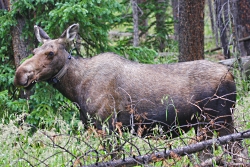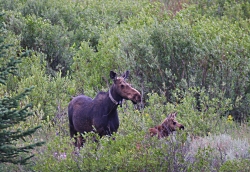
Alces alces
Courtesy & Copyright Sam Robertson, Photographer
It wasn’t’ until 1906-07 when the first recorded moose sighting occurred in Utah.
Ironically, at this same time the population of Shiras moose also known as Wyoming moose (the subspecies found in Utah today) was dangerously close to extinction due to overhunting.
Settlers in nearby states had preferred hunting moose because the large animal was easy to catch, and was an efficient way to obtain a few hundred pounds of sweet venison.
To prevent their extinction, western states discontinued moose hunting for a time. Until 1950, hunters agreed to hunt other deer species to provide time for the moose population to replenish.
Searching for moose became a challenging spectators sport.
Moose are active during the day and loners most of the year (except mothers with their young) and since they prefer habitat where they can easily hide – finding one was a rare occasion.
By 1957, Utah’s moose had a resident herd in the Uinta mountains and the population continued to grow.
Dan MacNulty, associate professor in the Department of Wildland Resources in the Quinney College of Natural Resource at USU has been studying the state’s moose. He explains, “Utah’s moose population reached an estimated high of over 3,500 in 2005. The population subsequently declined to a current estimate of 2,600 moose. The reasons for this drop were unclear.”
To determine the factors causing the fluctuation in the moose population, Utah Division of Wildlife Resources (DWR) joined with MacNulty’s research lab to investigate the drivers of moose population growth. MacNulty says, “The first priority of the research was to determine the current status of the moose population. Is it increasing, decreasing or stable?”

Courtesy & Copyright Sam Robertson, Photographer
Female moose are the best indicators of the health of the herd. The females provide the data to determine the health of both the adults and calves. By tracking them, the research team can see the number of females that calve, the number of calves who survive their first winter to join the population, and the survival rate of the adults during the four-year project.
When the first year of data was gathered they found in both herds, 80-90 percent of the collared females survived. Kent Hersey, Big Game Project Leader for DWR adds, “Compared to other moose herds, Utah moose tend to have average or below average survival rates.”
Joel S. Ruprecht, USU graduate student in MacNulty’s lab discovered one reason this may be occurring. He found the maternal fat stores of the female directly impact the reproductive and survival success in Shiras moose.
When midwinter fat stores of the expecting moose were measured Ruprecht found it predicted whether the female moose would successfully give birth to her young and also whether her young would live long enough to become a healthy long-term member of the herd.
If a solution for the population drop could be to increase nutrition levels of the mothers, then DWR may be able to improve habitat conditions for adult moose and increase their health, which would in turn increase calving rates.
DWR plans to use these research findings to help stabilize Utah’s moose population.
The results may have come at an ideal time since the state’s 7-year Statewide Moose Management Plan expires later this year.
This is Shauna Leavitt for Wild About Utah
Credits:
Photos: All photos copyright and courtesy of Sam Robinson.
Text: Shauna Leavitt, Utah Cooperative Fish and Wildlife Research Unit, Quinney College of Natural Resources, Utah State University
Additional Reading
Moose, Alces apces, compiled by Anthony Bell, Vertebrate Zoology Collections Assistant, Utah Museum of Natural History, https://nhmu.utah.edu/sites/default/files/attachments/Alces%20alces.pdf
Moose entering water, Jeff Rice, Western Soundscape Archive; University of Utah, https://collections.lib.utah.edu/details?id=1117822
Moose in Utah, Jason Pietrzak, Wild About Utah, Bridgerland Audubon Society/Utah Public Radio, 30 Sept 2008, https://wildaboututah.org/moose-in-utah/
Moose, Wild Aware Utah, Hogle Zoo & Utah Division of Wildlife Resources, https://www.wildawareutah.org/utah-wildlife-information/moose/
Utah Moose Statewide Management Program, Utah Division of Wildlife Resources, https://wildlife.utah.gov/hunting/biggame/pdf/moose_plan.pdf
